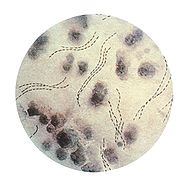قريح
| Photomicrograph of H. ducreyi | |
| ICD-10 | A57. |
| ICD-9 | 099.0 |
| DiseasesDB | 5563 |
| MedlinePlus | 000635 |
| eMedicine | emerg/95 |
| MeSH | D002602 |
Chancroid القرحة اللينة هو عدوى تنتقل جنسيا تتميز بقروح مؤلمة بالمناطق التناسلية. و معروف أن القرحة اللينة تنتشر من فرد الى آخر عن طريق المخالطة الجنسية.
الأسباب
القرحة اللينةعدوى بكتيرى تتسبب بواسطة fastidious موجبة الجرام streptobacillus Haemophilus ducreyi. وهو مرض ينتشر أساسا في الدول الدول النامية, متعلق بعمالة جنسيةو عملائها أو مايرتبط بها. مستويات العدوى قليلة في المجتمعات الغربية, حوالى 2 حالة في مليونان من السكان (كندا,فرنسا, المملكة المتحدة والولايات المتحدة). أغلب الحالات التى شخصت بالقرحة اللينة, كانت في زيارة الى الى بلدان أو مناطق معروفة بإنتشار المرض , وظهور حالات بصورة وبائية إرتبط بتعاطى الكوكايين . وإنتشار البغاء.
الرجال غير المختتنين معرضون للخطر أكثر 3 مرات من الرجال المختتنين في نشر القرحة اللينة circumcised من الشريك المصاب. القرحة اللينة هى معامل خطورة لنقل عدوى الإيدز HIV, نظرا الى إرتباطهم البيئى, أو إمكانية المخالطة,و بيولوجيا بتسهيل إنتقال العدوى من طرف الى آخر.
الظواهر و الأعراض
After an incubation period of one day to two weeks, chancroid begins with a small bump that becomes an ulcer within a day of its appearance. The ulcer characteristically:
- Ranges in size dramatically from 3 to 50 mm (1/8 inch to two inches) across
- Is painful
- Has sharply defined, undermined borders
- Has irregular or ragged borders
- Has a base that is covered with a gray or yellowish-gray material
- Has a base that bleeds easily if traumatized or scraped
More specifically, the CDC's standard clinical definition for a probable case of chancroid includes all of the following:
- Patient has one or more painful genital ulcers. The combination of a painful ulcer with tender adenopathy is suggestive of chancroid; the presence of suppurative adenopathy is almost pathognomonic.
- No evidence of Treponema pallidum is indicated by dark-field examination of ulcer or by a serologic test for Syphilis performed at least 7 days after the onset of ulcer.
- The clinical presentation is not typical of disease caused by human herpesvirus 2 (Herpes Simplex Virus), or result of culture for HSV is negative.
About half of infected men have only a single ulcer. Women frequently have four or more ulcers, with fewer symptoms. The ulcers appear in specific locations, such as the coronal sulcus of the uncircumcised glans penis in men, or the fourchette and labia minora in women.
المواضع التى يظهر بها المرض في الأنثى
In women the most common location for ulcers is the labia majora. "Kissing ulcers" may develop. These are ulcers that occur on opposing surfaces of the labia. Other areas such as the labia minora, perineal area, and inner thighs may also be involved. The most common symptoms in women are dysuria (pain with urination) and dyspareunia (pain with intercourse).
The initial ulcer may be mistaken as a "hard" chancre, the typical sore of primary syphilis, as opposed to the "soft chancre" of chancroid.
Approximately one third of the infected individuals will develop enlargements of the inguinal lymph nodes, the nodes located in the fold between the leg and the lower abdomen.
Half of those who develop swelling of the inguinal lymph nodes will progress to a point where the nodes rupture through the skin producing draining abscesses. The swollen lymph nodes and abscesses are often referred to as buboes.
العلاج
The CDC recommendation for chancroid is a single oral dose (2 tablets) of Azithromycin or a single IM dose of Ceftriaxone or oral Erythromycin for seven days.
المقارنة مع القرح
There are many differences and similarities between the conditions قرح chancre وقريح (reference 1 and 2)
- Both originate as pustules at the site of inoculation, and progress to ulcerated lesions
- Both lesions are typically 1-2 cm in diameter
- Both lesions are caused by sexually transmissible organisms
- Both lesions typically appear on the genitals of infected individuals
- Both lesions can present at multiple sites and with multiple lesions
- Chancre is a lesion typical of infection with the bacterium that causes syphilis, Treponema pallidum
- Chancroid is a lesion typical of infection with the bacterium Haemophilus ducreyi
- Chancres are typically painless, whereas chancroid are typically painful
- Chancres are typically non-exudative, whereas chancroid typically have a grey or yellow purulent exudate
- Chancres have a hard (indurated) edge, whereas chancroid have a soft edge
- Chancres heal spontaneously within three to six weeks, even in the absence of treatment
- Chancres can occur in the pharynx as well as on the genitals
الروابط الخارجية
- Vaccine Shown Effective Against Chancroid in Medical News Today (May 9, 2006). Retrieved on May 1, 2008.
المراجع
1. http://www.utdol.com/online/content/topic.do?topicKey=stds/7330
